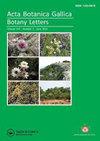How past riparian management practices can affect composition and structure of vegetation for headwater ecological restoration projects
引用次数: 8
Abstract
Abstract Ecological restoration of river networks, especially of headwaters, is a key issue to improve water ecological, chemical and physical qualities and ecological functioning of aquatic ecosystems. Ecological restoration of degraded riparian vegetation is commonly considered as an efficient way to improve headwater habitats. This study aims to describe past management dynamics and their effect on current riparian vegetation structure and composition. We focused on two headwater brooks surrounded by traditional pasture in the rural catchment of the river Oir, a salmonid nursery of the river Sélune, Normandy, France. Historical riparian vegetation dynamic has been characterized thanks to interpretation of ortho-photographs from 1947 to 2010. GIS analyses allowed us to distinguish five types of management practices from stable vegetation (maintained open or maintained woody) to heterogeneous dynamic vegetation (alternation of clear-cutting, coppice management and recolonization by ligneous species). To measure their impact on the riparian ecosystem, past management practices were linked with field data describing current structure and composition of riparian vegetation. Results show that structure of riparian plant communities depends mainly on recent management practices, while floristic composition depends both on recent and past management practices. Knowledge of the past dynamics of riparian landscapes proves to be a relevant indicator of the ecological status of headwater ecosystems that could be used to improve ecological restoration instead of classical management practices of riparian vegetation.过去的河岸管理措施如何影响水源生态恢复项目的植被组成和结构
摘要河网特别是源头河网的生态修复是改善水生态、化学、物理质量和水生生态系统生态功能的关键问题。退化河岸植被的生态恢复通常被认为是改善水源生境的有效途径。本研究旨在描述过去的管理动态及其对当前河岸植被结构和组成的影响。我们把重点放在了法国诺曼底ssamulune河的鲑鱼苗圃——Oir河乡村集水区被传统牧场包围的两条源头小溪上。通过对1947年至2010年的正射影照片的解译,对历史河岸植被动态进行了表征。GIS分析使我们能够区分五种类型的管理实践,从稳定植被(保持开放或保持木本)到异质动态植被(砍伐、灌木林管理和木本物种重新定居的交替)。为了衡量它们对河岸生态系统的影响,过去的管理做法与描述当前河岸植被结构和组成的实地数据相联系。结果表明,河岸植物群落结构主要受近期管理措施的影响,而植物区系组成则受近期和过去管理措施的影响。了解河岸景观的过去动态被证明是水源生态系统生态状况的一个相关指标,可以用来改善生态恢复,而不是传统的河岸植被管理做法。
本文章由计算机程序翻译,如有差异,请以英文原文为准。
求助全文
约1分钟内获得全文
求助全文

 求助内容:
求助内容: 应助结果提醒方式:
应助结果提醒方式:


